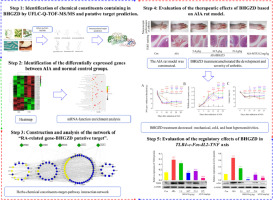当前位置:
X-MOL 学术
›
Phytomedicine
›
论文详情
Our official English website, www.x-mol.net, welcomes your
feedback! (Note: you will need to create a separate account there.)
Deciphering the chemical profile and pharmacological mechanisms of Baihu-Guizhi decoction using ultra-fast liquid chromatography-quadrupole-time-of-flight tandem mass spectrometry coupled with network pharmacology-based investigation.
Phytomedicine ( IF 6.7 ) Pub Date : 2019-12-23 , DOI: 10.1016/j.phymed.2019.153156 Weijie Li 1 , Xia Mao 2 , Hao Wu 3 , Minqun Guo 2 , Xiaohui Su 2 , Jianqiu Lu 4 , Qiuyan Guo 2 , Taixian Li 2 , Xiaoyue Wang 2 , Weiwei Su 3 , Yanqiong Zhang 2 , Na Lin 2
Phytomedicine ( IF 6.7 ) Pub Date : 2019-12-23 , DOI: 10.1016/j.phymed.2019.153156 Weijie Li 1 , Xia Mao 2 , Hao Wu 3 , Minqun Guo 2 , Xiaohui Su 2 , Jianqiu Lu 4 , Qiuyan Guo 2 , Taixian Li 2 , Xiaoyue Wang 2 , Weiwei Su 3 , Yanqiong Zhang 2 , Na Lin 2
Affiliation

|
BACKGROUND
Baihu-Guizhi decoction (BHGZD) has been extensively used for the treatment of rheumatoid arthritis (RA) with a satisfying therapeutic effect. However, the material basis and the underlying mechanisms of BHGZD against RA have not been fully elucidated.
PURPOSE
To investigate the chemical profile and the pharmacological mechanisms of BHGZD against RA.
METHODS
The chemical constituents containing in BHGZD were identified using UFLC-Q-TOF-MS/MS system, and the corresponding putative targets were predicted. Then, the differentially expressed genes (DEGs) between adjuvant-induced arthritis (AIA) and normal control groups were identified using microarray analysis. After constructing the interaction network of "RA-related gene-BHGZD putative target", BHGZD candidate targets against RA were screened by topological analysis and further experimentally validated based on AIA rat model.
RESULTS
A total of 41 chemical constituents were identified in the water extract of BHGZD, which were predicted to hit 1312 putative targets. Additionally, 26 DEGs between the AIA and normal control groups were defined as "RA-related genes", which were functionally involved into the imbalance of "inflammation-immune" system during RA progression. On the basis of the topological importance in the network of "RA-related gene-BHGZD putative target", 177 BHGZD candidate targets against RA were identified. Among them, TLR4, c-Fos/AP-1, IL2 and TNF had direct interactions with each other and also function as crucial components of toll-like receptor and T cell receptor signaling pathways, which may play important roles in maintaining the balance of "inflammation-immune" system. Experimentally, we verified that BHGZD dose-dependently attenuated the severity, pathological changes, as well as mechanical, cold, and heat hypersensitivities during RA progression based on the AIA rat model. Further western blot analysis demonstrated that BHGZD significantly reduced the protein levels of TLR4, c-Fos/AP-1, IL2 and TNF, which were induced by RA modeling, in the inflamed joints of AIA rats (all p<0.05).
CONCLUSION
This study combining the chemical and transcriptomic profilings, target prediction, network calculation and experimental validations identifies the chemical constituents containing in BHGZD and offers the convincing evidence that BHGZD may ameliorate RA partially by restoring the balance of "inflammation-immune" system and subsequently reversing the pathological events during RA progression through regulating the TLR4-c-Fos-IL2-TNF axis.
更新日期:2019-12-23











































 京公网安备 11010802027423号
京公网安备 11010802027423号